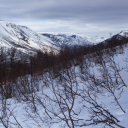Spring is yet to come in parts of Europe. I spent most of April in Norway working with collaborators in Trondheim, and was impressed by how much snow still remains in the mountains.
Lakes are still frozen, trees shrouded, and the high peaks buried under white cover. It is a very different landscape than the England I returned to.
But the snow isn’t everywhere. The variation in snowpack tells a fascinating story about where spring will come first. The first day of spring really comes on the date the ground becomes bare and life can return. And when the snow melts can vary by weeks even over a few meters of distance.
Wind can compact or drift the snow in some places, and blow it away from others. On ridge lines and mountaintops there are often complex patterns of bare ground brought on by these flows.
Darker surfaces absorb more heat, and melt snow faster. The dark tree bark of these trees has produced rings around each trunk, so that the ground will eventually open up near the trees sooner than away from them.
And landscapes’ orientation relative to the sun can lead to dramatic patterns of melt-out. This south-facing slope is bare and already supporting new growth while a meter of snow still sits on the north-facing slope of the same hill.
All of the ecology and growth of the organisms that need the summer warmth must follow these later-winter rhythms. When we look at a spring landscape, we are really seeing the history and the shadow of the snow that was once there. Winter does not end all at once, not anywhere.







